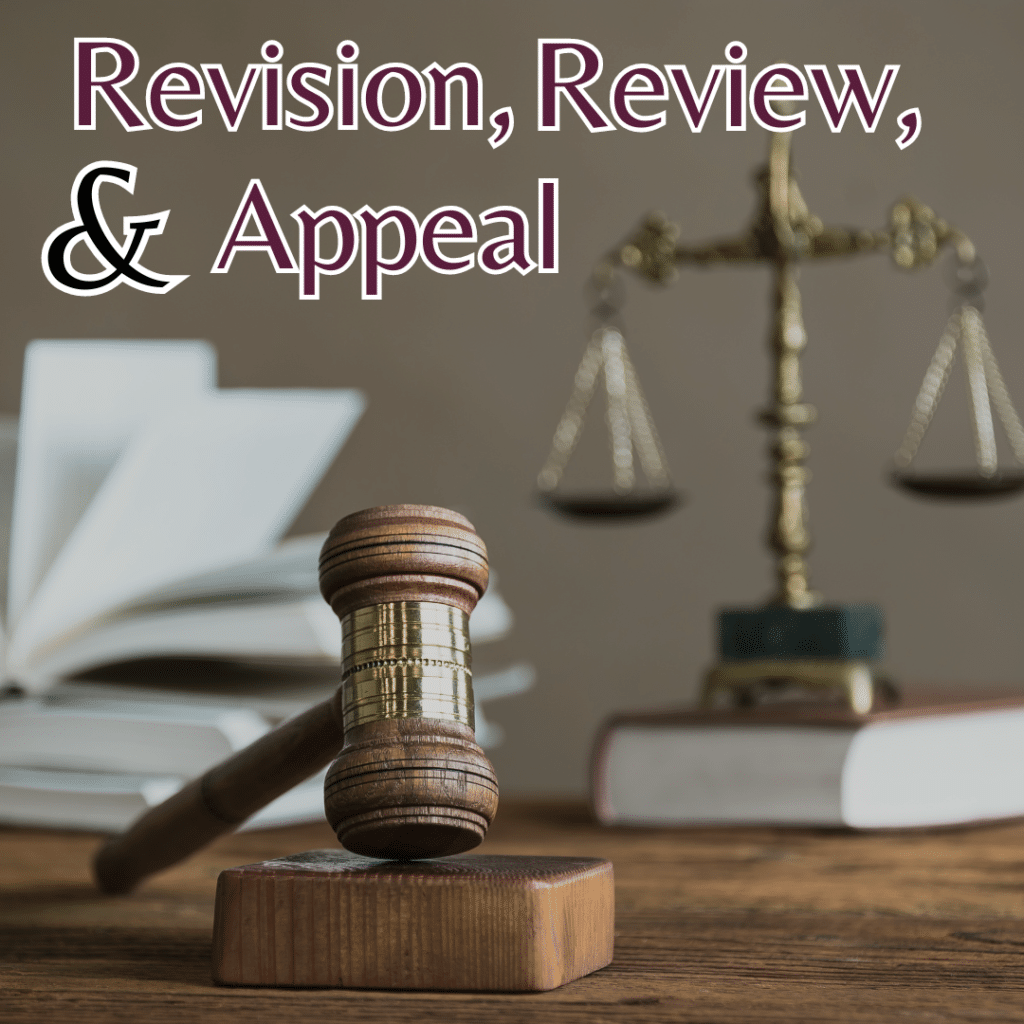
Authored By – Kanika Arora
Table of Contents
Revision, Review, and Appeal
Introduction
According to the Code of Civil Procedure, 1908 (CPC), a party that is offended by the court’s judgment may appeal the decision made by the trial court or lower court to a higher court better to grasp terms like reference, review, and revision. In the event of an appeal, the higher authority examines and rehearses the entire ruling. Nonetheless, the parties are not compelled to file a new case and submit an appeal if there is a prima facie error on a technical or procedural issue. Sections 113, 114, and 115 of the CPC provide reference review and amendment in such circumstances.
Revision
In its most literal sense, the word “revise” means “to look again,””to look at again,” or “to carefully consider a matter and make necessary corrections.”Section 115 of the Code of Civil Procedure, 1908[1], has given the High Court the authority to exercise revisional jurisdiction.
Object
The goal of giving the High Court revisional jurisdiction is to stop the lower court from arbitrarily, illegally, or irregularly exercising its jurisdiction. Section 115 gives the High Court the authority to monitor subordinate courts’ actions to ensure that they are carried out in line with the law, within its purview, and in the interest of justice, as was decided in Major S.S. Khanna v. Brig. F.J. Dillion[2]case.
Conditions
The conditions under which the High Court may exercise its revisional authority are outlined in Section 115 of the Code of Civil Procedure Code:
- A decision must be made in this circumstance.
- When there is no appeal available in the case that the subordinate court determined, the revisional jurisdiction is used.
- Such a case was determined by the subordinate court by:
- exercising jurisdiction that is not legally granted to that court., or
- It has not exercised the authority granted to it, or
- misuse of the authority granted to them or with inconsequential irregularities.
The subordinate court’s decision or order cannot be changed or overturned by the High Court unless it benefits the party who filed the revision request. Furthermore, if the High Court is the proper appellate forum in that case, the revisional jurisdiction cannot be used.
Therefore, by examining section 115, the lower Court’s jurisdictional mistakes are the primary focus of the amendment.
Review
The Civil Procedure Code defines the provision of review in Section 114[3]. In the event of a review, the party seeking review may apply to the court that issued the decree if they disagree with or feel wronged by its ruling. This clause was included to make it easier for the court to evaluate its decree or judgment and correct it if a mistake was made in rendering the decision.
In the case of Ram Baksh v. Rajeshwari Kunwar, AIR 1948 AII 213[4]it was decided that even in cases when the appeal is dismissed for any reason, there is still the possibility of review.
The review process is outlined in Order 47 of the CPC.[5]The parties may apply for review in the following circumstances:
- Although the decree or decision has a right of appeal, no appeal has been filed according to the law.
- If the statute for a certain decree or decision does not mention an appeal process.
- The ruling was made by the Court of Small Causes.
The following are the legal justifications for applying for review:
- where new facts are discovered that were unknown or impossible to produce at the time the edict was passed because of ignorance.
- If the error is discovered on the face of the record, the case does not need to be argued in its entirety afresh. These mistakes have nothing to do with the court’s incorrect rulings.
- The court’s delusion may serve as adequate justification in any other situation.
In S. Nagraj &Ors. V. State of Karnataka &Anr., 1993 Supp (4) SCC 595[6], the Apex court ruled that the term “any other sufficient ground” has an enlarged meaning. An order was fulfilled.
Object
Both judges and any other human can make mistakes or errors. To address errors and avoid future miscarriages of justice, the Review procedure has been incorporated into the legal system, as seen in the S. Nagraj v. State of Karnataka case. The review application is a request to recall and reexamine the decision rendered before the same court; it is not an appeal or revision to the superior court.
Conditions under which a review petition can be filed
The following situations allow for the court to hear a review petition:
- Where there is no basis for an appeal
The court may examine A judgment or order if there is no cause for appeal, as stated in section 114 of the law. It was decided in Ganeshi Lal v. Seth MoolChand[7]that an application for review against a decree issued by a Small Causes Court is permissible under subclause (c) of Section 114.
According to the ruling in the Ram Baksh v. Rajeshwari Kunwar[8] case, a party may pursue a review procedure even if their appeal is rejected for being ineligible or having expired.
- When a case has an appeal, but it is not preferred
A review petition is also maintainable in cases where the aggrieved party has the option to appeal, but chooses not to do so. According to the ruling in Sitaramasastry v. Sunderamma[9], a court motion for review may only be filed up until an appeal against that ruling is filed. When an appeal has been filed before applying for review, the court cannot consider the review request.
The expiration date of the review
A court other than the Supreme Court has thirty days from the date of the decree or order to apply for review under Article 124 of the Limitation Act, 1963.
Grounds for Review
A petition for the review of a ruling may be maintained on the following grounds, as specified by Rule 1 of Order 47:
- Upon the finding of novel and significant material or proof
When a new and significant piece of evidence that the petitioner could not have supplied or was unavailable when the decree was passed is discovered, the court has the authority to review its decision.
- Another compelling argument
Any adequate justification is the final basis for evaluation. This ground includes any sufficient ground that the court may examine for review. Any cause the court deems necessary to revisit its decision to prevent an injustice could be the basis.
The Supreme Court established in the Bank of Bihar v. Mahabir Lal[10]case several circumstances that can be deemed sufficient grounds for review, including when there has been any misapprehension of the true state of circumstances; when the party has not been afforded a fair opportunity to produce any statement or evidence; when the party has not received any notice; when the court has neglected to take into account a material fact or piece of evidence; or any legislative clauses have been left out by the court.
Appeal
After the final verdict is rendered, an appeal asks a higher court to examine and, if necessary, reverse the lower court’s decision and award the losing party’s side. The losing side must provide legal justification for why it believes the lower court’s decision was incorrect and should be reversed by the higher court. Here, the losing party and the appellant are required to demonstrate any flaws or faults made during the last trial.
There are two reasons why an appeal may be filed:
- When a mistake was made during the trial: This clause only takes into account serious mistakes. Errors that are not harmful are not appealable. The applicant must further demonstrate that his rights were violated as a result of the error.
- When there is inadequate evidence to support the verdict: It is far more difficult to establish an appeal based on insufficient evidence. Because the Court of Appeal did not hear all of the evidence in the prior trial and did not reach a completely objective conclusion. Most appeal courts consider the evidence before rendering a ruling, based on their faith in the trial court’s verdict.
Both the plaintiff and the defendant may pursue an appeal in a civil suit. Unless the ruling was made by the court of highest order, the defendant is entitled to submit an appeal. The court may reject an appeal for any number of reasons, including appellable errors, which give the court the right to reject any appeal.
When a party chooses to file an appeal, they need to remember that there is a deadline for filing that varies based on the jurisdiction. Nonetheless, the appeal court’s ruling is not subject to a deadline. After giving the matter careful thought, the judges of the court of appeals render a verdict.
Letters Patent Appeal (LPA)
An appeal from one bench of the same court to a bigger bench is known as a letters patent appeal. Section 50(1)(b) of the Arbitration and Conciliation Act, 1996 addresses this type of appeal, and the decision-maker must follow predetermined guidelines. This remedy was initially made available upon the creation of High Courts in 1865. The verdict rendered by the one-judge bench may be incorrect legally or owing to incorrect facts. Before appealing to the Supreme Court in these situations, the appellant may choose to refer to a more senior bench of the same court.
As a result, this would spare the costs associated with traveling to the Supreme Court and bringing a case. When submitted to the High Court, this type of appeal is known as an intra-court appeal; when filed under the Supreme Court, it is known as an inter-court appeal. An intra-court appeal may be filed for up to 90 days, and inter-court appeals may be filed for up to 30 days.
The appellant who files for an LPA must bring the following paperwork to the hearing after paying the court costs:
- Certified copy of the decree and decision that was appealed.
- Certified copy of the High Court-granted certificate.
- A certified copy of the decree issuing the aforementioned certification.
It is important to remember, nevertheless, that criminal proceedings do not allow for intra-court appeals.
Conclusion
revision, review, and appeal processes are crucial for maintaining fairness, accuracy, and accountability within systems. They provide mechanisms for correcting errors, ensuring independent scrutiny, and offering avenues for recourse, ultimately upholding the integrity and legitimacy of decision-making processes.
References
Bhandari Law Firm. (2024, February 23). Retrieved from https://bhandarilawfirm.com/difference-between-appeal-review-and-revision/
LAW Notes. (2024, February 23). Retrieved from https://lawnotes.co/appealreference-and-revision-cr-p-c/
Shonee Kapoor. (2024, February 23). Retrieved from https://www.shoneekapoor.com/difference-between-review-revision-and-appeal-in-civil-cases/





